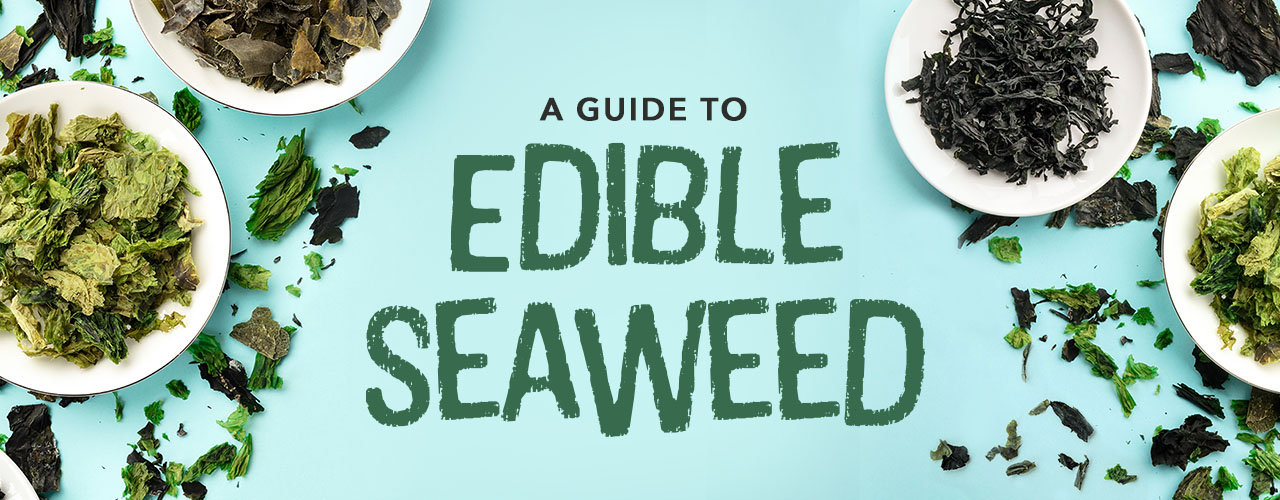When you think of edible seaweed, sushi rolls wrapped in green sheets of nori seaweed probably come to mind. But did you know there are countless types of edible seaweed? If you're wondering why anyone would want to eat these slippery ocean plants, we're here to tell you that seaweed is full of flavor and nutrients. More consumers are interested in nutritious plants and superfoods than ever before, so it's the perfect time to incorporate edible seaweed into your menu. Learn all about the most popular types of edible seaweed below.
Shop All Edible SeaweedWhat Is Seaweed?
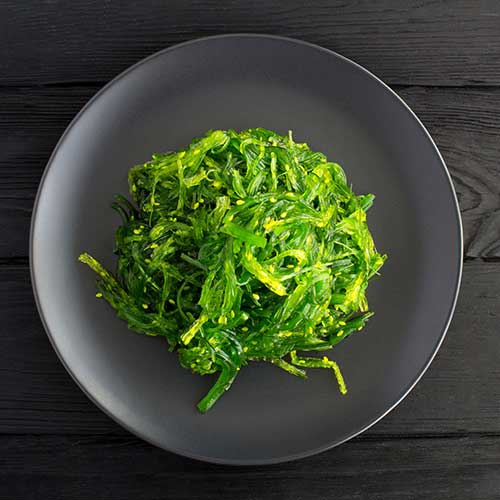
Seaweed is an umbrella term that represents numerous species of marine plants and large algae. In scope, you can compare the word seaweed to the word trees. Just like the immense variety of trees that grow on land, there are thousands of seaweed species growing in our oceans, rivers, and lakes.
Some seaweeds are tiny, while other species form vast underwater forests. Seaweed also makes up a very important part of the underwater food chain and provides shelter for marine life. Historically, edible seaweed has been a staple in the diet of many coastal cultures. It contains vitamins, minerals, and antioxidants that put it into the superfood category, but seaweed is also a great source of umami flavor, the elusive fifth taste.
What Color Is Seaweed?
Seaweed can be categorized into three different colors - red, green, and brown. Each of these sea vegetables has a different nutritional makeup, but all produce chlorophyll by photosynthesis. The darker red and brown seaweeds contain extra pigments that allow them to capture light in deeper waters. When they are cooked or soaked, the red or brown pigments dissolve and some sea plants turn green. These are the common types of seaweed by color:
- Green Seaweed (Chlorophytes) - Sea Lettuce, Umibudo
- Brown Seaweed (Phaeophytes) - Kombu, Wakame, Arame, Hijiki
- Red Seaweed (Rhodophytes) - Nori, Dulse, Irish Moss
Kelp vs Seaweed
Kelp is a type of brown seaweed that grows on the rocky shorelines of saltwater seas. It’s one of the largest types of seaweed and forms dense growths called kelp beds or kelp forests. A single kelp plant can grow over 200 feet in length. Another name for edible sea kelp is kombu.
Seaweed vs Algae
Seaweed is considered macroalgae (large algae), which is different from microalgae (also called phytoplankton). Macroalgae have stems and leaves that can be seen with the naked eye, while microalgae are microscopic, single-celled organisms.
Edible Seaweed List
If you're curious about the different types of edible seaweed and how to use them, we've made a list of the most popular sea vegetables you can find.
1. Nori
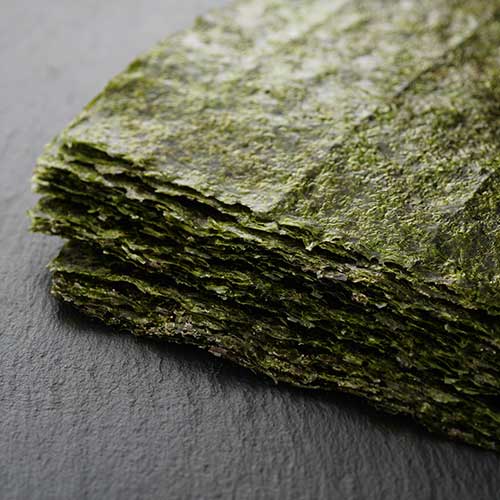
Thanks to our love of sushi, nori is probably the most well-known seaweed product in the US. You may not be aware that this edible red seaweed goes through extensive processing before it becomes part of your California roll. In fact, turning this sea vegetable into a sheet of nori is a lot like making traditional paper.
After a delicate farming process, nori fronds are washed, shredded, and combined with freshwater. The mixture is fed into a machine, pressed into sheets, and toasted. Nori sheets are sold in packs and graded for quality. The best grades of nori paper are greenish-black, shiny, and thick.
What Does Nori Taste Like?
Like many edible seaweeds, nori has a salty, briny flavor. The toasting process that is unique to nori also brings out a lightly sweet, smokey flavor. Its crisp texture is the perfect complement to the sticky rice and tasty fillings in a sushi roll.
How to Use Nori
Nori has many uses beyond just rolling sushi. It makes a great flavor enhancer for vegan and vegetarian foods when you want to capture the taste of seafood. Pulse a few sheets of toasted nori in a food processor and add the flakes to dips, soups, and noodle dishes. Because of their salinity, nori flakes also make a great salt substitute in your homemade spice blends.
2. Wakame

If you’ve enjoyed a warm bowl of miso soup with small green squares in the broth, you’ve eaten wakame seaweed. This edible brown seaweed is best known for being added to soups, but it’s also the main ingredient in seaweed salads. Dried wakame comes in dark, shriveled pieces, but once it’s reconstituted in water, it turns green and reveals a satiny texture.
Wakame vs Nori
Wakame and nori are two different types of edible seaweed. Nori is a red seaweed that goes through extensive processing before being sold in paper-like sheets. Wakame is dried before being packaged but otherwise, it’s minimally processed, unless it's being used as an ingredient in prepared seaweed salad products.
What Is Seaweed Salad?
Seaweed salad (also called goma wakame) is a popular dish on sushi menus in the US and Europe, but not so much in Japan. This prepared salad consists of long, silky tendrils of wakame mixed with sesame oil, soy sauce (or a soy sauce substitute), and other seasonings. Surprisingly, the wakame used in the dish is not the fresh form of the sea vegetable. Wakame must be trimmed and processed to create the long noodle-like shape that seaweed salad is known for.
3. Kombu (Konbu)
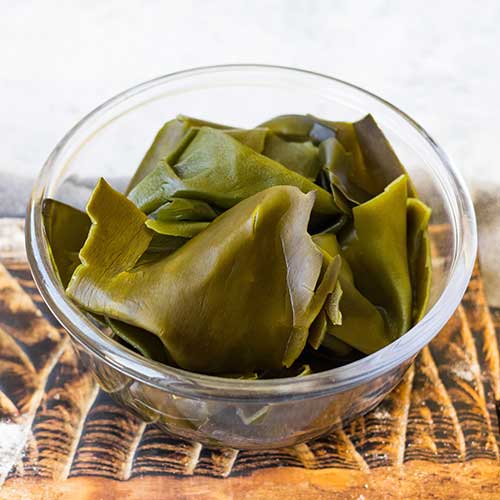
Kombu (konbu in Japan) is a type of kelp known for containing high levels of monosodium glutamate (MSG), the compound responsible for umami flavor. The most popular use for kombu leaves is to make savory dashi broth, which is a staple cooking ingredient in Japan. In the West, animal products are used to flavor stocks, but in Japan, kombu is the go-to flavor enhancer. This makes it a useful ingredient for plant-based cooking.
How to Use Kombu
It’s very easy to make a flavorful broth with kombu. When you unpackage dried kombu, you may notice the leaves are covered in a white, powdery substance. This is crystallized monosodium glutamate, which is safe to eat and also provides more flavor to your soup base. If there is grit or sand on the kombu leaves, wipe it away gently with a wet cloth. You can simmer kombu leaves in hot water or soak them overnight in cold water to make a delicate but rich plant-based broth.
Kombu can also be used to make a soothing kelp tea called konbu-cha, not to be confused with the fermented beverage kombucha.
Wakame vs Kombu
Wakame and kombu are both types of brown seaweed, but they have different textures and uses. Wakame is thin and silky, while kombu can be thick and rubbery. Delicate wakame leaves add a pleasing texture to soups and salads. Sturdy kombu leaves are mainly used to add flavor to stocks and broths, but they can also be simmered and used as an ingredient.
4. Dulse
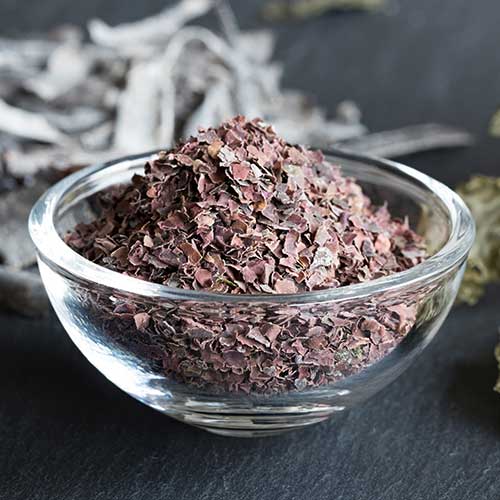
The next sea vegetable on our list is dulse, a type of red seaweed with deep red, purplish fronds and a palm-like shape. Dulse grows in the cool waters of the Northern Atlantic and Arctic oceans and has been eaten by coastal communities in Europe and North America for centuries. During the Irish potato famine of 1845, foraging for dulse was common in Ireland and this seaweed became a substantial dietary staple.
What Does Dulse Taste Like?
Dulse is hailed as a great bacon substitute because of its salty, savory flavor. Try pan-frying dulse flakes for a crispy snack or use it as an ingredient in sandwiches and salads. Dulse powder can also be used to add umami flavor to soups, stews, or sauces. Another unexpected use for this seaweed is to make a compound butter that combines rich, creamy butter with flavorful dulse flakes.
Dulse vs Kelp
Dulse is a type of red seaweed, and kelp is a brown seaweed. Both of these sea vegetables are edible and contain a variety of vitamins and nutrients. Dulse is most commonly sold as dried flakes or powder, while types of kelp like kombu are sold in dried strips or pieces.
5. Arame

Arame is a type of brown seaweed in the kelp family. This feathery sea vegetable is mostly hand-harvested from the clean waters of a protected Japanese bay, Ise-Shima. The fronds are shredded and dried, and the packaged form of arame looks like wispy, black noodles. Arama has a mild, slightly sweet taste and can be added to stir-fries, noodle dishes, and salads.
Hijiki vs Arame
Arame is visually similar to another type of brown seaweed called hijiki. Both sea vegetables have a thread-like appearance, but arame is shredded while hijiki is naturally stringy when dried. Hijiki has come under fire for containing inorganic arsenic, which can be harmful at high levels. Arame is a safe substitution to use in recipes if you want to avoid hijiki.
6. Umibudo (Seaweed Grapes)
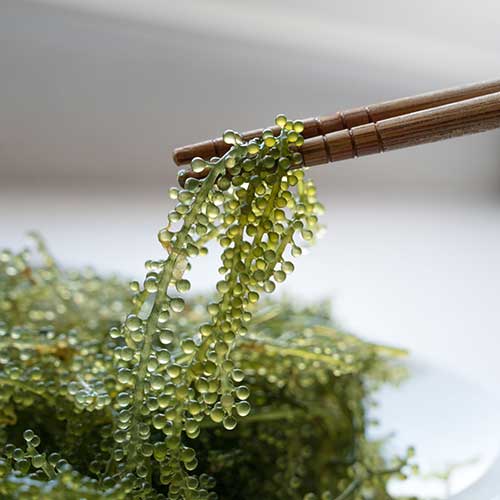
Probably the most unique sea vegetable on our list, sea grapes look like a cluster of small green grapes. The tiny green bubbles of this edible seaweed have a texture and pop similar to fish roe, which is why it's also referred to as green caviar. Fresh sea grapes aren't widely available outside of Asia, but they can be purchased from online specialty stores in their dried form.
What Do Sea Grapes Taste Like?
Sea grapes are salty, sweet, and slightly acidic. The small pearl-like clusters of "grapes" pop in your mouth like real fish caviar. Serve sea grapes on their own with a side of soy sauce or as a garnish on sushi, sashimi, or rice bowls.
Edible Seaweed FAQs
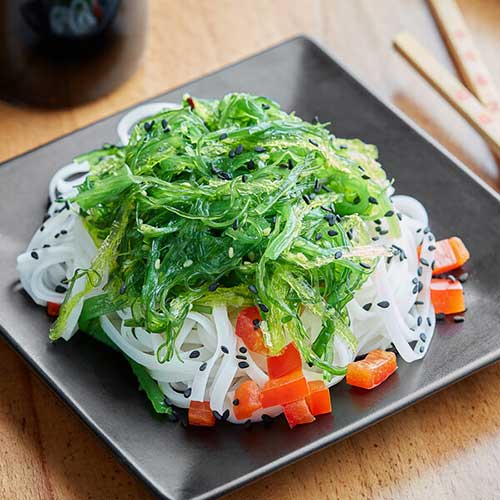
Where Does Seaweed Come From?
Seaweed grows in oceans, rivers, and lakes. Most of the edible seaweed on the market is grown in underwater plots, but some is cultivated in saltwater tanks. Hand-harvested seaweed can also be found in specialty shops. Seaweed farming is a fast-growing sector of aquaculture and can be a lucrative, sustainable replacement for fishing in areas that have been overfished.
Is All Seaweed Edible?
Many kinds of seaweed are edible, but not all types have an appetizing flavor or texture. The seaweeds on our list represent some of the tastiest sea vegetables that you can find. Foraging for fresh seaweed has become popular in the states, but it's important to keep in mind that seaweed will absorb the pollutants of its environment. Stay away from foraged seaweed that grows in busy harbors or stagnant waters.
Is Seaweed Safe to Eat?
Seaweed is safe for most people, but it contains high levels of iodine and potassium, which could be harmful to those with thyroid issues. One type of seaweed, hijiki, has been shown to contain potentially harmful inorganic arsenic. Some countries, including Canada, have issued warnings to limit consumption of hijiki for this reason.
Seaweed can be a fun, new ingredient to experiment with, especially since the Western palate is growing to appreciate this umami-flavored sea vegetable. Try adding dried edible seaweeds like nori or dulse to sauces and spice blends for an ocean-inspired kick. You'll be surprised at how much flavor a piece of kombu can add to your soups. As an added bonus, edible seaweed is a nutrient-dense superfood with a host of health benefits!
